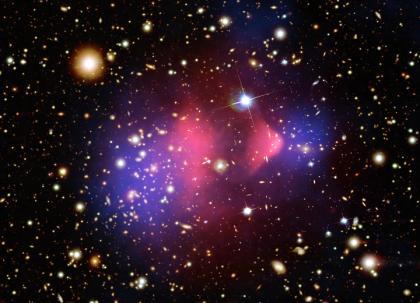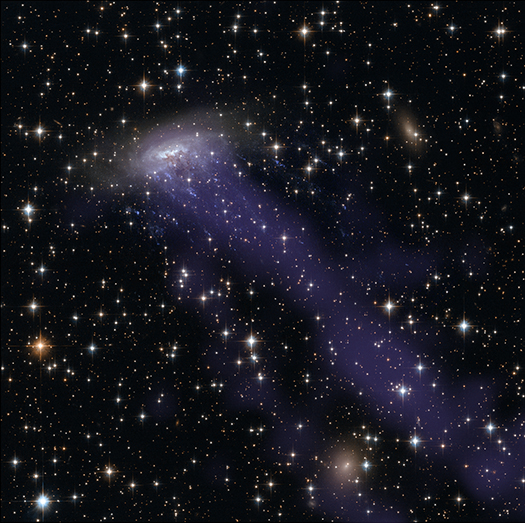Professional and Amateur Astronomers Join Forces
We are perhaps living in the midst of a new "Golden Age" of astronomy. In the four hundred years since Galileo first trained his refracting optical telescope on the Moon, and Jupiter and its moons, we've seen staggering advances in the technology of telescopes. We've also benefited from the discoveries of light beyond the visible portions of the electromagnetic spectrum and the development of instruments sensitive to those wavelengths.
Supernova Cleans Up its Surroundings
Supernovas are the spectacular ends to the lives of many massive stars. These explosions, which occur on average twice a century in the Milky Way, can produce enormous amounts of energy and be as bright as an entire galaxy. These events are also important because the remains of the shattered star are hurled into space. As this debris field - called a supernova remnant - expands, it carries the material it encounters along with it.
Hardy Star Survives Supernova Blast
When a massive star runs out fuel, it collapses and explodes as a supernova. Although these explosions are extremely powerful, it is possible for a companion star to endure the blast. A team of astronomers using NASA's Chandra X-ray Observatory and other telescopes has found evidence for one of these survivors.
Dr. Belinda Wilkes Chosen to Lead the Chandra X-ray Center

Professor Charles Alcock, Director of the Harvard-Smithsonian Center for Astrophysics, announces that after an extensive search, the Smithsonian Astrophysical Observatory (SAO), in consultation with NASA, has selected Dr. Belinda Wilkes as the next director of the Chandra X-ray Center (CXC). She will assume the directorship on April 20, 2014.
Welcome to the 344th Carnival of Space

Welcome to this week's Carnival of Space. Let's see what's going on in the Universe and those who write about it.
Over at the Urban Astronomer, they cover what the Curiosity rover has been doing on Mars for the past year and how it's faring in reaching its science goals.
What Makes an Astronomical Image Beautiful?
Astronomy is renowned for the beautiful images it produces. It's not hard to be impressed by an image like the Pillars of Creation or the Bullet Cluster, and the more eye-catching an image is, the bigger an audience it can potentially reach. So, as part of our job in astronomy outreach, we have each spent time thinking about what makes an astronomy image beautiful. As professionals, we’d like to go well beyond the intuition of the person who says, "I don't know anything about art, but I know what I like". One approach(1) is to list the key elements that make an image beautiful.
 |
 |
Two famous images, the Pillars of Creation from the Hubble Space Telescope on the left and the Bullet Cluster from the Chandra X-ray Observatory, Hubble and ground-based observatories on the right. Credit: left: NASA, ESA, STScI, J. Hester and P. Scowen (Arizona State University); right: X-ray: NASA/CXC/CfA/M.Markevitch et al.; Optical: NASA/STScI; Magellan/U.Arizona/D.Clowe et al.; Lensing Map: NASA/STScI; ESO WFI; Magellan/U.Arizona/D.Clowe et al.
Celebrating Women History's Month
March is recognized as "Women's History Month" by entities around the country including the federal government. The Chandra X-ray Center is located at the Smithsonian Astrophysical Observatory (SAO) in Cambridge, Mass., which has long been tied to the Harvard College Observatory (HCO) in what is known as the Harvard-Smithsonian Center for Astrophysics (CfA).
Chandra & XMM-Newton Provide Direct Measurement of Distant Black Hole's Spin
Multiple images of a distant quasar are visible in this combined view from NASA's Chandra X-ray Observatory and the Hubble Space Telescope. The Chandra data, along with data from ESA's XMM-Newton, were used to directly measure the spin of the supermassive black hole powering this quasar. This is the most distant black hole where such a measurement has been made, as reported in our press release.
Life Is Too Fast, Too Furious for This Runaway Galaxy
The spiral galaxy ESO 137-001 looks like a dandelion caught in a breeze in this new composite image from the Hubble Space Telescope and the Chandra X-ray Observatory.
The galaxy is zooming toward the upper right of this image, in between other galaxies in the Norma cluster located over 200 million light-years away. The road is harsh: intergalactic gas in the Norma cluster is sparse, but so hot at 180 million degrees Fahrenheit that it glows in X-rays detected by Chandra (blue).







